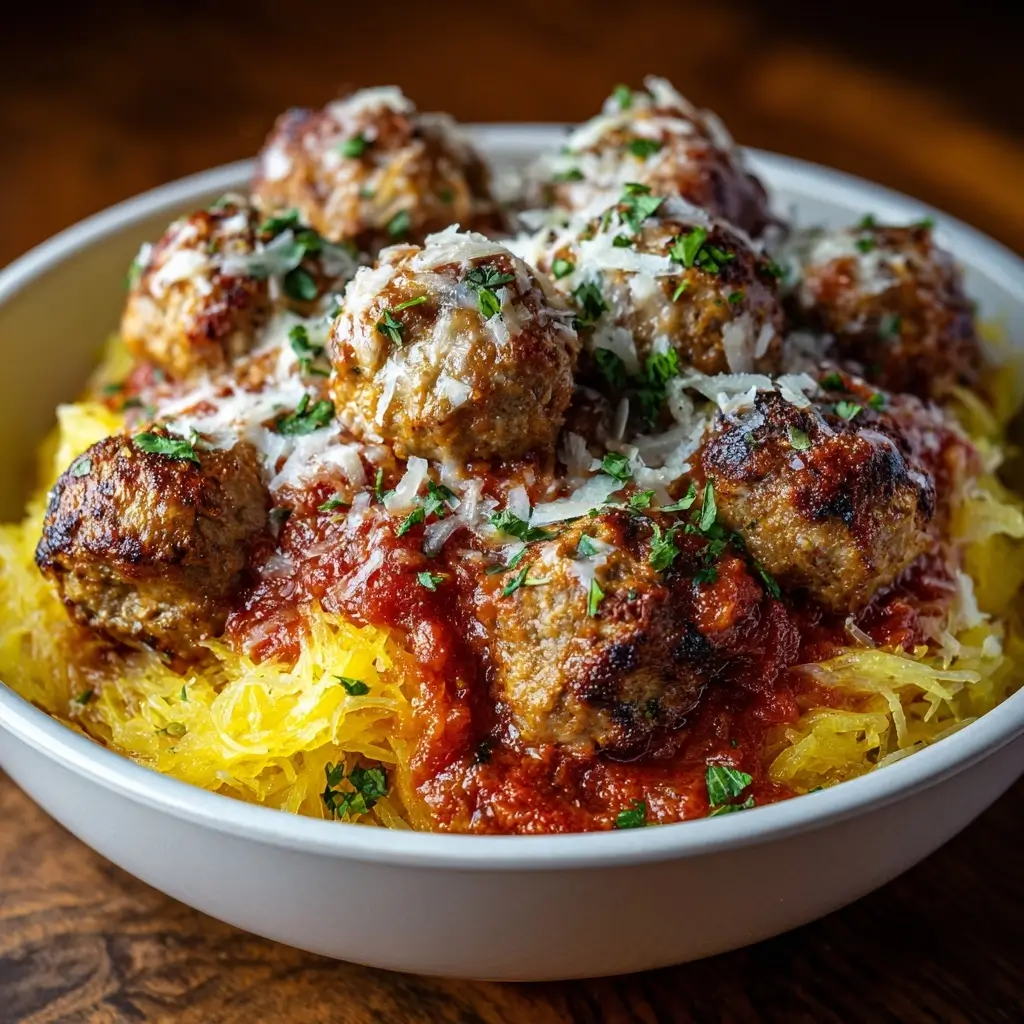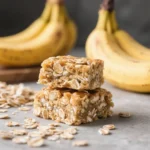Spaghetti Squash with Meatballs: A Healthy, Hearty, and Flavor-Packed Meal
If you’re looking for a comforting yet nutritious twist on the classic spaghetti and meatballs, look no further than spaghetti squash with meatballs. This dish combines the natural sweetness of roasted spaghetti squash with tender, savory meatballs in a rich tomato sauce, creating a satisfying meal that’s lower in carbs and higher in nutrients than traditional pasta dishes. Whether you’re following a low-carb, gluten-free, or simply health-conscious lifestyle, this recipe is sure to become a favorite in your weekly rotation.
The History
While spaghetti squash may seem like a modern culinary invention tailored to contemporary dietary trends, its roots trace back thousands of years. Native to Central and South America, spaghetti squash (a type of winter squash) was cultivated by indigenous peoples long before European contact. It gained popularity in North America during the 20th century, particularly after World War II, as home gardeners began experimenting with new vegetable varieties.
The concept of pairing spaghetti squash with meatballs is a relatively recent innovation, emerging alongside the growing interest in low-carbohydrate and grain-free diets. As people sought healthier alternatives to refined pasta, spaghetti squash—named for its unique flesh that separates into long, noodle-like strands when cooked—became a popular substitute. Combining it with Italian-style meatballs and marinara sauce pays homage to classic Italian-American cuisine while offering a lighter, nutrient-dense version of the beloved comfort food.
Ingredients Breakdown
The beauty of spaghetti squash with meatballs lies in its balance of wholesome ingredients that deliver bold flavor without excess calories or processed components. Let’s break down each component:
- Spaghetti Squash: Low in calories and carbohydrates, high in fiber, vitamin C, and antioxidants. When roasted, its flesh naturally separates into spaghetti-like strands.
- Ground Meat (Beef, Turkey, or Pork): Provides protein and richness. Lean ground turkey makes this dish lighter, while beef offers a deeper, more traditional flavor.
- Breadcrumbs (or Gluten-Free Alternative): Helps bind the meatballs. Use whole wheat, almond flour, or gluten-free breadcrumbs depending on dietary needs.
- Egg: Acts as a binder to keep meatballs moist and cohesive.
- Grated Parmesan Cheese: Adds umami and helps enhance moisture and flavor in meatballs.
- Garlic and Onion: Foundational aromatics that build depth in both meatballs and sauce.
- Fresh Herbs (Parsley, Basil, Oregano): Brighten flavors and add freshness.
- Olive Oil: Used for roasting and sautéing; provides heart-healthy fats.
- Crushed Tomatoes or Marinara Sauce: The base of the sauce—rich in lycopene and naturally low in sugar if unsweetened.
- Seasonings (Salt, Pepper, Red Pepper Flakes, Bay Leaf): Enhance overall taste and provide subtle heat and complexity.
Optional additions include mushrooms (for umami), grated zucchini (to increase moisture and sneak in veggies), or nutritional yeast (for a vegan cheesy flavor).
Step-by-Step Recipe
Follow these detailed steps to create a perfectly balanced and flavorful spaghetti squash with meatballs dish from scratch.
- Preheat Oven: Set your oven to 400°F (200°C). Line a large baking sheet with parchment paper or lightly grease it with olive oil.
- Prepare Spaghetti Squash: Carefully cut the spaghetti squash in half lengthwise using a sharp chef’s knife. Scoop out the seeds and stringy pulp with a spoon (save the seeds for roasting later if desired).
- Rub with Oil and Season: Drizzle the cut sides with olive oil and sprinkle with salt and pepper. Place the halves cut-side down on the baking sheet.
- Roast Squash: Bake for 35–45 minutes, or until the flesh is tender and easily pierced with a fork. Remove from oven and let cool slightly. Once safe to handle, use a fork to scrape the inside of each half, pulling out the strand-like flesh. Set aside.
- Prepare Meatball Mixture: In a large bowl, combine 1 pound of ground meat, 1/2 cup breadcrumbs, 1/4 cup grated Parmesan, 1 beaten egg, 2 minced garlic cloves, 1/4 cup finely chopped onion, 2 tablespoons fresh parsley, 1 teaspoon dried oregano, 1/2 teaspoon salt, and 1/4 teaspoon black pepper. Mix gently with your hands until just combined—do not overmix to avoid tough meatballs.
- Form Meatballs: Roll the mixture into 1.5-inch balls (about 18–20 meatballs). Place them on a plate or tray.
- Cook Meatballs: Heat 1 tablespoon olive oil in a large skillet over medium heat. Brown the meatballs on all sides (about 6–8 minutes total), working in batches if needed. They don’t need to be fully cooked at this stage—just seared. Remove and set aside.
- Sauté Aromatics: In the same skillet, add another tablespoon of olive oil if needed. Sauté 1/2 chopped onion and 2 minced garlic cloves until fragrant and translucent (about 2–3 minutes).
- Add Tomato Sauce: Pour in 24–32 oz of crushed tomatoes or marinara sauce. Stir well, scraping up any browned bits from the bottom of the pan for extra flavor.
- Simmer Sauce: Add 1 teaspoon dried basil, 1/2 teaspoon oregano, a pinch of red pepper flakes, and a bay leaf. Bring to a gentle simmer.
- Add Meatballs to Sauce: Gently place the seared meatballs into the sauce. Cover and simmer on low heat for 20–25 minutes, or until meatballs are cooked through and tender.
- Combine and Serve: Divide the roasted spaghetti squash strands among plates or bowls. Top generously with meatballs and sauce. Garnish with fresh basil, extra Parmesan, and a drizzle of olive oil if desired.
Tips
- Choose the Right Squash: Look for a medium-sized spaghetti squash (about 2–3 pounds). Larger ones can be watery; smaller ones yield less flesh.
- Don’t Overcook the Squash: Over-roasting can make the strands mushy. Check at 35 minutes to ensure optimal texture.
- Use a Fork to Shred: Always use a fork to scrape the flesh after roasting—it creates perfect “noodles” effortlessly.
- Keep Meatballs Tender: Avoid overmixing the meatball mixture. Handle gently and don’t pack too tightly when rolling.
- Browning Adds Flavor: Searing meatballs before adding them to the sauce enhances their taste through the Maillard reaction.
- Simmer Slowly: Letting meatballs cook slowly in the sauce allows them to absorb flavor and stay juicy.
- Make Ahead: Roast the squash and prepare the sauce with meatballs up to 3 days in advance. Reheat gently on the stove.
- Freeze for Later: Fully cooked meatballs and sauce freeze beautifully for up to 3 months. Thaw overnight and reheat.
Variations and Customizations
This recipe is highly adaptable to suit various tastes, dietary preferences, and cultural twists:
- Vegan Version: Replace meatballs with lentil-walnut or chickpea-based plant “meatballs.” Use flax eggs and nutritional yeast instead of dairy and eggs.
- Low-Carb/Keto: Use almond flour or crushed pork rinds instead of breadcrumbs. Opt for sugar-free marinara sauce.
- Gluten-Free: Substitute regular breadcrumbs with certified gluten-free oats or GF breadcrumbs.
- Turkey or Chicken Meatballs: For a leaner option, use ground turkey or chicken. Add extra olive oil or grated zucchini to prevent dryness.
- Mediterranean Twist: Add sun-dried tomatoes, olives, feta cheese, and oregano to the sauce for a Greek-inspired flavor profile.
- Spicy Kick: Increase red pepper flakes or add diced jalapeños to the sauce for heat lovers.
- Creamy Alfredo Style: Skip the tomato sauce and toss spaghetti squash with a creamy Alfredo sauce made from Greek yogurt, Parmesan, garlic, and butter.
- Asian Fusion: Swap Italian herbs for ginger, soy sauce, and sesame oil. Serve meatballs in a teriyaki glaze over the squash.
- Stuffed Squash Boats: Instead of serving separately, return the cooked squash halves to the oven and fill them with meatballs and sauce. Top with mozzarella and bake until bubbly.
Health Considerations and Nutritional Value
Spaghetti squash with meatballs isn’t just delicious—it’s also packed with nutritional benefits that support overall wellness.
- Low in Calories and Carbs: One cup of cooked spaghetti squash contains only about 40 calories and 10 grams of carbohydrates (7 grams net), making it ideal for weight management and low-carb diets.
- High in Fiber: Both the squash and whole-grain breadcrumbs contribute dietary fiber, promoting digestive health and satiety.
- Rich in Vitamins: Spaghetti squash is a good source of vitamin C, vitamin B6, and beta-carotene (which converts to vitamin A), supporting immune function and skin health.
- Protein-Packed: Meatballs made with lean ground beef or turkey provide about 15–20 grams of protein per serving, helping maintain muscle mass and keep you full longer.
- Heart-Healthy Fats: Olive oil and Parmesan offer monounsaturated fats and calcium without excessive saturated fat when used in moderation.
- Lycopene Boost: Cooked tomatoes in the sauce are rich in lycopene, an antioxidant linked to reduced risk of certain cancers and heart disease.
- Diet-Friendly: Easily adapted for keto, paleo, gluten-free, dairy-free, and diabetic-friendly diets with simple swaps.
However, be mindful of sodium content if using store-bought sauce or pre-seasoned breadcrumbs. Opt for low-sodium versions or make your own sauce to control salt levels. Also, portion size matters—while healthy, oversized servings can still lead to calorie surplus.
Ingredients
For the Spaghetti Squash:
- 1 medium spaghetti squash (2.5–3 lbs)
- 1 tbsp olive oil
- ½ tsp salt
- ¼ tsp black pepper
For the Meatballs:
- 1 lb ground beef (or turkey, pork, or plant-based alternative)
- ½ cup breadcrumbs (regular, whole wheat, or gluten-free)
- ¼ cup grated Parmesan cheese
- 1 large egg
- 2 cloves garlic, minced
- ¼ cup onion, finely chopped
- 2 tbsp fresh parsley, chopped
- 1 tsp dried oregano
- ½ tsp salt
- ¼ tsp black pepper
For the Sauce:
- 1 tbsp olive oil
- ½ cup yellow onion, diced
- 2 cloves garlic, minced
- 24–32 oz crushed tomatoes or marinara sauce (low-sugar preferred)
- 1 tsp dried basil
- ½ tsp dried oregano
- ¼ tsp red pepper flakes (optional)
- 1 bay leaf
- Salt and pepper to taste
Garnishes (Optional):
- Fresh basil or parsley
- Extra grated Parmesan
- Red pepper flakes
- Drizzle of balsamic glaze or olive oil
Directions
- Roast the Squash: Preheat oven to 400°F. Cut spaghetti squash in half lengthwise and scoop out seeds. Drizzle cut sides with olive oil and season with salt and pepper. Place cut-side down on a lined baking sheet. Roast 35–45 minutes until fork-tender. Cool slightly, then scrape out flesh with a fork. Set aside.
- Make Meatballs: In a large bowl, combine ground meat, breadcrumbs, Parmesan, egg, garlic, onion, parsley, oregano, salt, and pepper. Mix gently until just combined. Form into 18–20 balls.
- Sear Meatballs: Heat olive oil in a large skillet over medium heat. Brown meatballs on all sides (6–8 minutes), working in batches. Remove and set aside.
- Build Sauce: In the same skillet, add more oil if needed. Sauté onion until soft (3 mins), add garlic and cook 1 minute. Pour in tomatoes, basil, oregano, red pepper flakes, bay leaf, salt, and pepper. Stir well.
- Simmer Meatballs: Return meatballs to the sauce. Cover and simmer on low for 20–25 minutes, stirring occasionally, until meatballs are cooked through.
- Assemble: Divide spaghetti squash among bowls. Top with meatballs and sauce. Garnish with fresh herbs, Parmesan, and a drizzle of oil if desired.
- Serve Warm: Enjoy immediately while hot and fragrant!
FAQ
Can I microwave the spaghetti squash?
Yes! Pierce the whole squash several times with a knife, microwave on high for 10–12 minutes (turning halfway), then slice open, remove seeds, and roast briefly if desired for better texture.
How do I store leftovers?
Store in an airtight container in the refrigerator for up to 4 days. Reheat in a skillet or microwave.
Can I freeze this dish?
Yes. Freeze sauce and meatballs together for up to 3 months. Spaghetti squash is best reheated fresh but can be frozen with slight texture changes.
Why are my meatballs falling apart?
Likely due to insufficient binder (egg or breadcrumbs) or overmixing. Ensure proper ratio and mix gently.
Is spaghetti squash really like pasta?
It has a similar texture—mild, slightly sweet, and strand-like—but lacks the chew of wheat pasta. It absorbs sauces well, making it an excellent base.
Can I use frozen meatballs?
Absolutely. Use high-quality frozen meatballs and simmer in sauce according to package directions. Adjust seasoning as needed.
What can I serve with this dish?
Pair with a crisp green salad, garlic bread (or cauliflower toast), steamed broccoli, or roasted vegetables for a complete meal.
Summary
Spaghetti squash with meatballs is a wholesome, flavorful fusion of traditional Italian comfort food and modern healthy eating. Packed with nutrients, easy to customize, and deeply satisfying, it’s a dinner the whole family will love.










